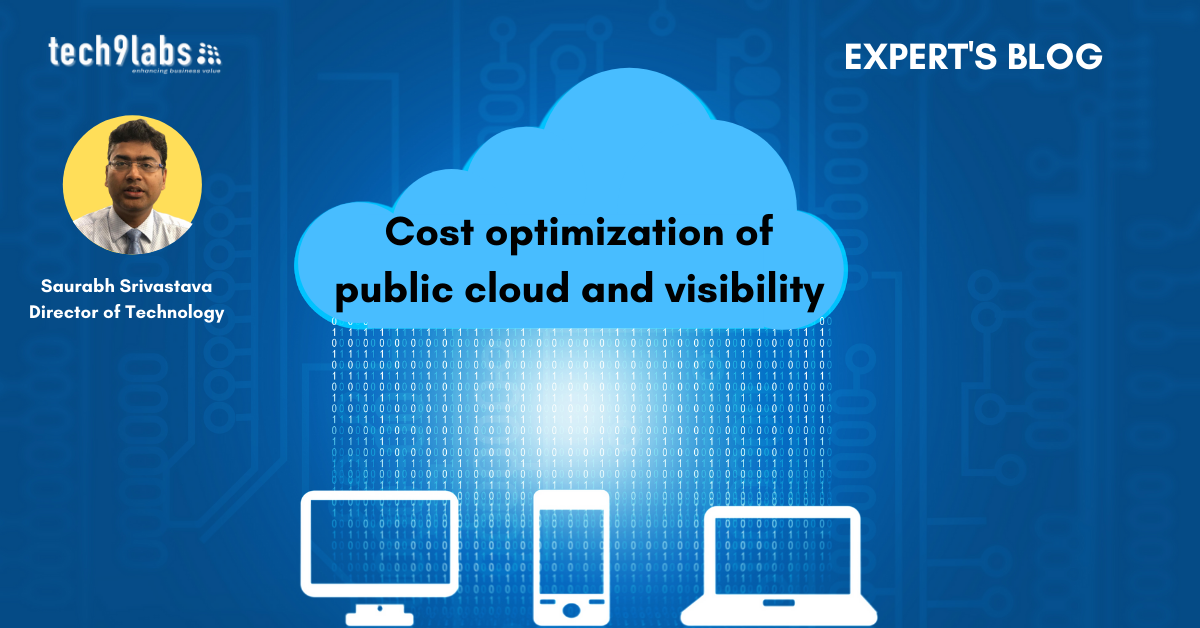Cost Optimization of Public Cloud and Visibility to the Business
Financial Governance in the cloud
Cloud is now getting so popular that controlling spend in the cloud has overshadowed all other concerns like security, complexity etc. Companies should create the process of creation of Annual operating plan covering all IT and related cost and give real time visibility to all stakeholders for visibility of the cloud cost and taking corrective actions for controlling the cost. Below is an approach for continuous Financial Governance, cloud cost control points and proposed governance structure involving three departments i.e. IT, Finance and Business/Lob’s.
Cloud costs are ballooning. More than eighty percent of large enterprises will overshoot their cloud budgets this year, according to Gartner. The success of cloud is in many ways its worst enemy. Once companies are in the cloud, one-click or automated provisioning of cloud resources can quickly lead to hefty bills.
In 2018-19, one of the large financial software company, paid $ 145 million to AWS for cloud services, a multi-fold increase from the year before. Left unattended, this overspending will negatively impact the bottom line. In a recent survey, more than 85% of organisations acknowledged that poor cloud cost management slows or stop further cloud adoption.
“Roughly 35% of cloud computing spending is wasted via instances that are over-provisioned and not optimized, according to RightScale.”
Effective cost management is therefore an immediate need for the organisation. Majority of the senior IT professionals say that managing cloud spend is their top priority. Those companies who keep continuing hold of the usage and their patterns, positively impact and reduce cost by more than 15%.
Some organisations have tried to implement cost management solutions. These technologies decrypt billing trends across hybrid or multi-cloud configurations and recommend where to eliminate inactive storage, change instance types or opt for lower cost clouds and regions. However, they are only point solutions and fail to align the business objective, plans, P&L and processes.
Design principles for a holistic cloud cost management:
1) Start with the basics of traditional IT Cost management:
IT should be able to track howmoney is spent on cloud matched with accounting and plan how much money will be spend in the future through budget process. How well these tracking activitiesare implemented will determine how well IT or business can control cloud costs.
2) Incorporate the characteristics of the cloud expense:
To keep pace with the utility model of cloud i.e. pay per use cloud model, infrastructure financial structure needs to shift from Capex to Opex. This will have far reaching impact for industries like utilities, BFSI or other capital-intensive industries who favour Capex. The vast pool of on demand access of a variety of cloud services require continuous monitoring and reconciliation process with finance team for preventing over-spend.
3) Use and integrated multi dept. or LOB approach:
For controlling the cost, technology team should closely work with Finance and business LOB’s or departments. Each of these units must understand and take ownership of cost activities:
a) Technology team to review if they really need the kind of resources and efficiently configured and optimized the setup in public cloud?
b) IT Finance team to find out if there is a balance between cost and value of the services hosted in the cloud?
c) Business/LOB team to find if cloud resources are being used in effective way?
Technology team should work out the most cost-effective architecture for the business and making sure workloads run as optimized and efficiently in the cloud as possible. The IT finance team must get used to the utility cost model of cloud computing including elasticity and usage-based billing. Business must be able to budget for the new and ongoing projects based on the yearly budget planning and take corrective actions in case of changes in the strategy basis business outcome and abnormal cost bills and usage.
Some of the important actions while framing the cost control framework in the public cloud:
Resource Tagging: This is the process of define and implement metadata (Tags) that will identify all the cloud resources like storage, network, compute etc.The tags allow other capabilities to function, including cost tracking, reporting and allocating resources to various business units. Tagging helped organisation to quickly identify the resources are being used for which dept and help in finding out orphaned resources.
Resource budgeting: Run by business units that own P&L, this capability estimates the usage of cloud resources based on the historic trends and estimated future demand.Budgeting starts with business service usage and can be applied to the granular projection of cloud resource usage.This enable business to estimate budget per service cost with allocation rules are applied. This can be applied every month for visibility of the cost Vs. the value, revenue/generated from the related apps and infrastructure hosted in cloud.
Budget and resource control: This capability compares the actual cost of running in the cloud Vs. the budget and takes immediate actions to turn off/add resources as needed.When significant gaps are identified, corrective actions should be performed.IT should implement permissions control for creation of new services in cloud so that only authorised users can provision resources. The resource quota policies help prevent unforeseen spikes in the usage. IT should control spending with programmatic budget notifications and automated budget actions makes it easier to stay within defined budget and increase predictability.
Cost Allocation:Here the IT finance team overseas the allocation of direct and indirect costs on the general ledger to cost centre (Hardware, software, manpower cost and services) as well as core business practices and capabilities. These allocations can be done manually or automatically using a set of rules pre aligned and accepted by all parties. Awell-executed tagging of cloud resources and a set of rules predefined and aligned in advance will provide the transparency and cost accountability that will enable business managers to make the right decisions.
Contractual Model optimization: This process ensures optimized contractual models with cloud service provider (CSP) and related vendors. System integrators partner (SI) can offer deeper discounts on cloud contracts due to premium partnership with CSP’s. Consolidating billing across multiple accounts into a master account allows the benefit of reaching the higher discount slabs faster. Use of reserved instances and spot instances- through Auto Scaling Group where appropriate can further optimize cloud cost.
Architecture Optimization:Finally, technology practitioners must work with the business and finance teams on the technical architecture to make use of cloud native functionalities that can further optimize bills. Tools like AWS Autoscaling or serverless functions can be used to adjust capacity to maintain low and predictable cost performance. In addition, re-platforming to take advantage of PaaS solutions can bring additional operational and financial benefits. We can further speed up the deployment which improved efficiencies when we use the advantage of DevOps, microservices and dynamic scaling i.e. Faster deployment means lesser cost.
With these foundational pieces in place, cloud cost management can become a cloud capability that delivers tangible value to the business. Business, IT and Finance team must all be on the same page and understand the cost behind the resources utilized.
Same process can be applied for optimizing and finding out the real cost in on-prem IT environment with a granularity to the per transaction IT cost. Business team can relate this to per customer revenue cost and find out efficiency areas for identifying the cost hot spots and increasing the bottom line.









